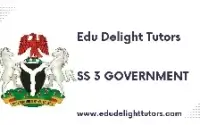Mock Exams SS 3 Literature English
EDU DELIGHT TUTORS MOCK EXAMINATION
Subject: Literature-in-English
Class: Senior Secondary School 3 (SS3)
Time Allowed: 2½ Hours
Instruction: Answer all questions in Section A and any 5 questions from Section B
SECTION A – OBJECTIVE QUESTIONS (30 Marks)
Choose the most appropriate option A–D and write only the letter that corresponds to your answer.
-
Literature can be broadly defined as:
A. An expression of feelings only
B. Written records of science
C. Works of fiction, drama and poetry
D. Storytelling only -
A literary device in which an object represents an idea is called:
A. Irony
B. Allusion
C. Symbolism
D. Sarcasm -
Which of the following is a characteristic of drama?
A. Presence of stanza
B. Dialogue and stage directions
C. Use of narrative prose
D. Use of rhymes -
The major division of a play is called:
A. Line
B. Chapter
C. Scene
D. Act -
A protagonist is:
A. A supporting character
B. The leading character
C. The narrator
D. A poetic line -
The central message or underlying idea in a literary work is the:
A. Setting
B. Theme
C. Plot
D. Characterization -
A sonnet consists of how many lines?
A. 8
B. 10
C. 12
D. 14 -
A poem written to mourn the dead is known as:
A. Ballad
B. Sonnet
C. Ode
D. Elegy -
Which of these writers is known for African drama?
A. Chinua Achebe
B. Wole Soyinka
C. William Shakespeare
D. Niyi Osundare -
“Things Fall Apart” was written by:
A. Ngugi wa Thiong’o
B. Chimamanda Adichie
C. Chinua Achebe
D. Ola Rotimi -
Which genre of literature uses rhyme, rhythm and meter?
A. Fiction
B. Poetry
C. Drama
D. Prose -
The setting of a literary work refers to:
A. The theme
B. The characters
C. Time and place
D. The point of view -
A direct comparison using “like” or “as” is called:
A. Metaphor
B. Simile
C. Hyperbole
D. Alliteration -
A figure of speech that exaggerates for effect is called:
A. Euphemism
B. Hyperbole
C. Onomatopoeia
D. Metonymy -
Which of these playwrights wrote The Lion and the Jewel?
A. Ola Rotimi
B. Ngugi wa Thiong’o
C. Wole Soyinka
D. Ama Ata Aidoo -
A literary work that criticizes human foolishness using humour is:
A. Tragedy
B. Satire
C. Allegory
D. Farce -
The peak or turning point of a narrative is called the:
A. Exposition
B. Denouement
C. Climax
D. Conflict -
Who is the tragic hero in Oedipus Rex?
A. Creon
B. Oedipus
C. Jocasta
D. Tiresias -
The rhyme scheme ABAB CDCD EFEF GG is typical of:
A. Limerick
B. Italian sonnet
C. Shakespearean sonnet
D. Ballad -
One of the functions of literature is to:
A. Entertain only
B. Provide scientific knowledge
C. Mirror society
D. Record historical wars only -
The narrator in a novel is referred to as the:
A. Character
B. Protagonist
C. Point of view
D. Voice -
“He is a lion on the battlefield” is an example of:
A. Irony
B. Metaphor
C. Simile
D. Personification -
A drama without music, comedy or tragedy is called:
A. Farce
B. Melodrama
C. Pantomime
D. Mime -
“And the heart that fed” is a line from which poem?
A. “The Proud King”
B. “Ozymandias”
C. “The School Boy”
D. “Shall I Compare Thee to a Summer’s Day” -
“Death be not proud” was written by:
A. John Milton
B. John Donne
C. William Blake
D. William Wordsworth -
The moral lesson of a story is also known as the:
A. Plot
B. Theme
C. Setting
D. Character -
In drama, aside means:
A. A solo performance
B. A monologue
C. A statement made by a character to the audience
D. A group dialogue -
Who is the author of A Raisin in the Sun?
A. Lorraine Hansberry
B. August Wilson
C. Chinua Achebe
D. Arthur Miller -
“The woman is a rock in troubled times” is an example of:
A. Simile
B. Irony
C. Metaphor
D. Oxymoron -
Literature helps to develop all these EXCEPT:
A. Moral values
B. Emotional response
C. Creativity
D. Mathematical formulas
SECTION B – THEORY QUESTIONS (70 Marks)
Answer only 5 questions. All questions carry equal marks.
-
(a) Define literature and explain its three main genres.
(b) List two purposes of literature in society. -
Analyze any one African poem you have studied, explaining its theme, tone, and poetic devices used.
-
(a) Differentiate between comedy and tragedy in drama.
(b) Discuss the significance of dialogue in a play. -
Examine the theme of corruption and leadership in any African prose you have studied.
-
Discuss any character who exemplifies heroism or selflessness in a novel or play you have read.
-
Explain the following literary devices with examples:
(i) Irony
(ii) Alliteration
(iii) Flashback
(iv) Personification -
Identify and discuss the role of women in African literature using any relevant text.
-
(a) What is a sonnet?
(b) Compare the structure of the Petrarchan and Shakespearean sonnet. -
(a) Explain the term “dramatic irony.”
(b) Cite one example of dramatic irony in any play you have studied. -
Write short notes on the following literary terms:
(i) Setting
(ii) Mood
(iii) Theme
(iv) Conflict
(v) Climax
(vi) Denouement


